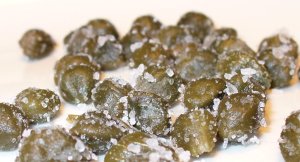Culinary capers
Why we grow water thirsty crops like rice and cotton in this wide brown land – the second driest continent in the world – is beyond me. With rivers that have been reduced to veritable trickles and water tables that have been severely compromised, pursuing soggy agricultural opportunities is unthinking bravado.
Even growing edible bamboo off season for the Asian food market looks good on paper but no rain… no water and this damp-loving grass falters and investors go down the toilet. But there are distinct opportunities with the right sort of crops – and so-called Mediterranean types seem to lead the charge. Olives have certainly taken off in a big way providing Australian consumers with fresh less travelled oils. This week I glimpsed the world of the caper producer.
I was at a gathering of Flavour SA members – diligent and enthusiastic producers of a range of excellent produce in South Australia. But it was Barry Porter and his ‘Kolophon’ capers to whom I kept returning.
What a fascinating crop. Here’s a scrubby shrub of historic culinary significance that has tenaciously developed a drought tolerant survival protocol. Traditionally found in the hot and arid southern European countries and on the North African coast of the Mediterranean Sea capers are culinary staples in the Mediterranean basin.
While the perennial caper plant only grows to around 1.2 metre in height it has a root system that goes beyond deep. It sends out several stages of root matrices at different levels to capture any moisture well beyond its surface footprint – and below one matrix of roots is another to capture any moisture that could have snuck through the first. In that respect it is like an iceberg of the plant world.
Related to a cabbage, although more like a trailing rose bush in appearance, caper bushes produce three edible variants: six graded sizes of caper although, Barry has streamlined his choices to large and small, caperberries which are the fruit of the flower from an unpicked caper bud and pickled sprigs of leaves often found in Greek meals.
Being local and fresher, the ‘Kolophon’ caperberries had more crunch and texture than most imported ones I’d munched. The ‘Kolophon’ experimentation with various Australian salts for preserving the capers produced an excellent result and I began envisaging a chicken piccata and a puttanesca (whore’s) pasta ….but then I’m such a tart for a good caper and Australia is making some beauties.
